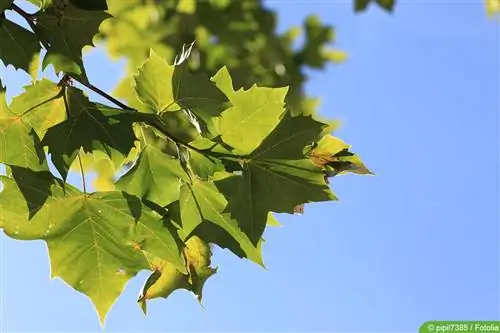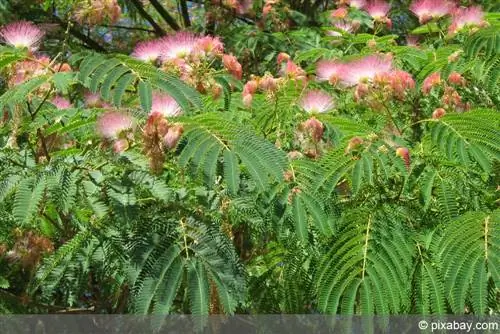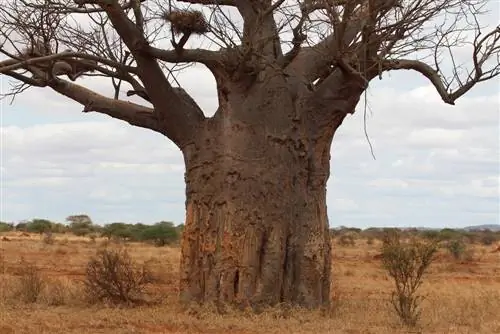- Author admin [email protected].
- Public 2023-12-17 03:39.
- Last modified 2025-01-24 12:45.
In the wild, the tamarind tree can grow up to 25 meters tall. Of course, the plant does not reach such heights in our latitudes for climatic reasons. As a distinctive potted plant, the tree still looks quite impressive. It's just unfortunate that Tamarindus indica, its Latin name, can quickly become a major challenge for hobby gardeners. But with the necessary knowledge it works.
Location
Tamarindus indica likes it warm and bright. A sunny location with as much light as possible is therefore a must. During the growth phase, the plant cannot get enough sunlight. It is clear that, against this background, a winter garden is a good choice as a location - especially since there is usually the space that the tree needs. Alternatively, larger rooms in the house are also available. However, they should also be in a sunny location and, if possible, have large windows. If the temperature is above 15 degrees Celsius, the tamarind can also be placed on the balcony or terrace. Here the plant should also be protected from the wind. The following applies: the younger she is, the more protection she needs. By the way, older trees should definitely be left outside as long as the temperatures allow it.
Note:
A location on the windowsill is of course possible, but the space there will quickly become too small. Wherever the tree is placed, you should definitely not underestimate the plant's great light requirements.
Substrate
The soil for Tamarindus indica should be as permeable and contain humus as possible. Older plants may also contain some clay. In principle, high-quality garden soil is perfect for the tree in the pot. However, it is important that it is enriched with drainage material to ensure reliable water drainage and to prevent the formation of waterlogging. Pebbles, pottery shards or even perlite are the right choice for this.
Pouring
The tamarind tree requires relatively little water. One reason for this may be that it grows relatively slowly. However, this does not mean that the soil in which the tree is located should dry out completely. Rather, watering should always be done when the soil surface in the trunk area begins to dry out slightly. This guarantees that the all-important root ball is kept moist throughout. On the other hand, this also ensures that no waterlogging occurs in or on it. There is therefore no fixed rule as to the rhythm at which the tree should be watered. Rather, it is necessary to check the soil daily and then use the watering can if necessary.
Tip:
The watering water should always be at room temperature. This prevents the relatively sensitive plant from getting something like a cold shock when watering.
Fertilize
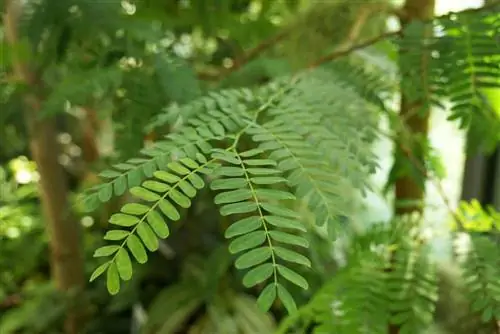
Tamarindus indica also needs nutrients to grow and thrive. The substances contained in the soil will soon no longer be sufficient for this. Then there is no way around regular fertilization. It is best to use complete fertilizer for green plants. Liquid fertilizer that you simply pour into the water is ideal. Fertilization time is from April to September. During this phase it is necessary to provide nutrients approximately every two weeks. Alternatively, you can also use commercially available fertilizer sticks that you simply stick into the soil. When dosing, please follow the manufacturer's instructions.
Cutting
Pruning is not absolutely necessary for tamarind. It grows so slowly that there is little risk of uncontrollable growth. The growth and lushness of this plant cannot usually be promoted by regular pruning. However, depending on the location, it may be necessary to shape the tree a little. Then you can't avoid removing annoying branches or shoots. The rule is that cutting may only be carried out after winter rest. The cut is made about three to five millimeters above a sleeping eye. The cut should be made at a slight angle to allow any water to drain away. Regardless of this, it is of course necessary to remove diseased branches and dead wood from the trunk.
Repotting
You probably can't say it often enough: the tamarind tree grows extremely slowly. But even if the progress is not always immediately noticeable, it will still increase given the right conditions. As a result, you can't avoid repotting it into a larger planter. Experience has shown that this is necessary about every three years - and only when the bale has completely rooted.
Wintering
Tamarindus indica is neither hardy nor can it survive without a rest period. Even temperatures below ten degrees Celsius can be dangerous. It's a good thing that the tree doesn't necessarily need a special winter quarters. It just can't be left outside after it has spent the summer there. A darkened room is also not necessary. Quite the opposite: This plant needs a lot of light even when it is resting. Basically, the following requirements should be met during winter storage:
- as bright a location as possible
- Room temperature between 15 and 20 degrees Celsius
- no too dry air (heating)
Against this background, a winter garden is usually something like the perfect refuge for the plant. Unfortunately, even there it can be relatively dark during the winter months or it can get dark too early. In any case, there is a great risk that the tree will not receive enough light, even in an otherwise very sunny location. Therefore, the less light there is, the lower the room temperature should be. In general, a temperature of 20 degrees Celsius should not be exceeded. Watering is greatly reduced during the dormant phase and fertilization is completely avoided.
cultivation
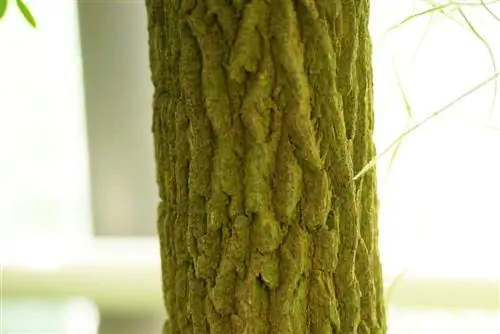
Most hobby gardeners and plant lovers will get a tamarind tree as a young plant from a gardening store. However, it is also possible to grow your own tamarind. The best way to do this is to get ripe tamarind fruits from an Asian shop. Each individual fruit contains an average of four seeds. In order to use them, they must first be completely freed from the pulp. That's not always easy. It usually only helps to suck the seeds until every last bit of pulp is gone. It is usually only then that you can tell whether the seeds are ripe and suitable for germination. If they are dark brown in color, you are usually on the safe side.
Pretreatment
However, it is not enough to simply put the seed in the ground. The tamarind seeds have a particularly hard shell that is intended to protect against unintentional germination. This germ protection must definitely be removed. Either you sand it very carefully with very fine sandpaper or you soak the seed in warm water for a full day. The latter is of course the much safer option.
Planting the core
Once the germ protection is removed, you can plant the seeds. Coconut substrate is perfect for this. It should be placed in a narrow and relatively high planter. Once a filling level of around 75 percent has been reached, the seed is placed in the middle and then covered with a thin layer of substrate. This layer should be just thick enough that the seed can no longer be seen. Then everything is pressed firmly and watered vigorously. The vessel is then moved to a warm place. After about two to eight weeks, the seeds begin to germinate. It forms the first leaves and a taproot.
Planting the young plant
As soon as the first leaves appear, the plant needs a lot of light and a lot of warmth. The young tamarind should be transplanted from around five pairs of leaves. Garden soil with drainage material is now recommended as a substrate. In addition, a lot of light and heat are still required. However, the container must not be placed on the heater, otherwise the entire substrate would dry out very quickly. Rather, the substrate must be kept moist throughout, but must never be wet in order to avoid waterlogging. By the way, a sprayer is ideal for water supply in this phase. Direct sunlight should be avoided. Fertilization is only necessary for the first time after about two months.


